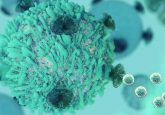SOLO-1: practice-changing results for advanced ovarian cancer patients with BRCA mutation

SOLO-1 is the first, double-blind, randomized, prospective Phase III trial to evaluate front-line olaparib maintenance therapy after platinum-based chemotherapy in newly diagnosed advanced ovarian cancer with BRCA mutation. In this exclusive interview we speak with Kathleen Moore (University of Oklahoma, OK, USA) to find out how the results could change practice, the possibility of extrapolating this data to other high-grade serous carcinomas and Kathleen’s upcoming research.
Could you provide us an overview of the SOLO-1 trial and the results that were recently presented at ESMO?
The SOLO-1 study was an international, Phase III randomized trial that enrolled women who were diagnosed with stage III or IV ovarian cancer, have a mutation in BRCA either germline or somatic, had an attempt at a surgery and had either a complete or partial response to chemotherapy. They were then randomized in a 2:1 fashion to 300mg twice daily of olaparib versus placebo, which was continued until disease progression or if there was no disease progression the treatment was stopped at 2 years. The primary endpoint was progression free survival (PFS) and the secondary endpoints were overall survival, progression free survival 2 and time to first and second subsequent therapies and quality of life. A total of 391 women were enrolled. The study demonstrated an unprecedented improvement in PFS from a median of 13.8 months among the placebo arm to a median that – with 41 months of follow up- has not even been reached but appears to be 3 years longer for olaparib than placebo. Based on Kaplan Meier estimates, at 3 years, 60.4% of patients on olaparib and 26.9% of patients on placebo were disease free. The hazard ratio for the difference in PFS was 0.3 (95% CI 0.23–0.41). PFS2 was also significantly superior for the olaparib arm with a hazard ratio of 0.5 (95% CI 0.35– 0.72). There was no clinically meaningful change from baseline in quality of life detected.
How do you hope this trial might affect the clinical practice on the frontline of care?
The results of SOLO-1 should be immediately practice changing. We need to operationalize the ability to test for BRCA early, really at the time of diagnosis, so that appropriate treatment plans can be made. This is an extraordinary result – women who are eligible for olaparib maintenance as per study definitions should be allowed to access olaparib as soon as possible.
At ESMO the possibility of extrapolating this data to other high-grade serous carcinomas was discussed, could you provide your thoughts?
At this point, the SOLO-1 data only relates to BRCA patients. There are several completed and maturing trials that will evaluate the use of a PARPi as maintenance in other biomarker subgroups such as homologous recombination repair deficient patients and in all comers. This data should be available in 2019 making it a very exciting year as we will see whether PARPi use has a meaningful impact on PFS beyond BRCA.
What are your big plans for the next few years? / What further investigations do you have planned?
Exciting options will be combinations in front line ovarian cancer treatment: IMagyn050 is looking at the combination of atezolizumab and bevacizumab vs bevacizumab alone in combination with front line chemotherapy. FIRST is looking at niraparib, bevacizumab and TSR-042 (immune checkpoint inhibitor) in various combinations in first line treatment of ovarian cancer. JAVELIN 100-PARP is evaluating combinations of talazoparib (PARPi) with avelumab as maintenance vs. talazoparib alone vs standard of care bevacizumab maintenance. DUO-O is evaluating combinations of olaparib and durvalumab and anti-angiogenesis agents. There are also several other trials looking at combinations in the front line to try and improve outcomes. These trials are open globally so women across the world should have access.
The next steps are to achieve this magnitude of finding in non-BRCA patients. BRCA patients make up only 20–25% of ovarian patients, so we still have a large percentage of patients that deserve our full attention to improve outcomes. This will come through participation and support of clinical research. Clinical trials are how we discover the next big advancements in cancer treatment, so we need to make sure our patients understand that the best way for them to be treated for ovarian cancer – or for any cancer is to be treated on a clinical trial.
Profile: Kathleen Moore
I serve as the Associate Director for Clinical Research and the Director of Early Phase Drug Development at the Stephenson Cancer Center at the University of Oklahoma (OK, USA). I served as the international Co-PI for the SOLO-1 study (GOG 3004).
I receive honoraria/consulting fees from Astra Zeneca, Genentech/Roche, Immunogen, Merck, Janssen, Tesaro, Clovis, VBL Therapeutics, Aravive and OncoMed.





